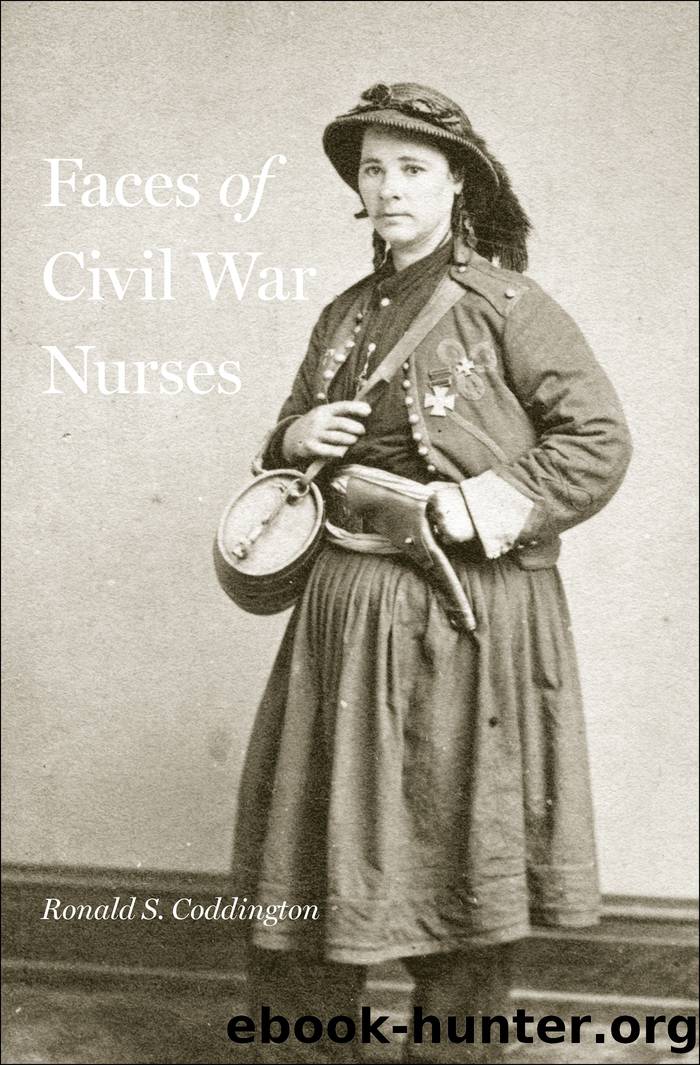Faces of Civil War Nurses by Ronald S. Coddington

Author:Ronald S. Coddington
Language: eng
Format: epub
Publisher: Johns Hopkins University Press
Published: 2020-11-15T00:00:00+00:00
Mary Ann Ball Bickerdyke. Carte de visite by Samuel Montague Fassett (1825â1910) of Chicago, Illinois, about September 1863.
Foard Collection of Civil War Nursing
The Nurse of Nurses during the War
BITTERLY COLD WINDS HOWLED ACROSS SOUTHERN TENNESSEE, roared over Lookout Mountain, and swept into the valley below during the last day of 1863. Torrents of freezing rainfall followed in their wake and tore with a vengeance into the Union army troops encamped in and about Chattanooga. No one suffered more than the sick and wounded. In a field hospital on the edge of a forest about five miles from town, mountain gales overturned tents and left about 1,500 patients exposed to the elements. Medical personnel stoked firepits with more and more wood as night set in and the cold intensified. Before long a cordon of crackling blazes provided much-needed warmth around the battered camp. About midnight, the wood ran out. The fires began to dieâand when they did, so might the suffering soldiers. The head surgeon believed it would be futile to order men into the icy forest to cut trees and replenish the fuel. He encouraged everyone to hold on as best they could until morning and went to bed.
In this dire moment a nurse stepped up and took charge. Mary Bickerdyke appealed to soldiers of the Pioneer Corps in camp. She asked them to pull down nearby breastworks and harvest the logs. The tired, shivering men were reluctant to do so without orders from a superior officer, but Mary persuaded them to act. She provided them with steaming cups of panadoâa concoction of hot water, sugar, crackers, and whiskeyâto warm their bones. Thus reinforced, they set out with mules, axes, hooks, and chains. While the members of the Pioneer Corps threw themselves into their life-saving work, Mary directed others to brew caldrons of panado and other hot drinks for the rest of the men. She even prepared warm meal to keep up the strength of the mules as they hauled logs to feed the hungry fires. According to one account, Mary ran from tent to tent with hot bricks in one hand and steaming drinks in the other as she cheered and comforted all.
Just when the crisis appeared to be averted, thirteen ambulances that had been stranded in the storm creaked into camp. Mary and the rest of the medical personnel leapt into action to aid half-frozen drivers and mules, as well as frostbitten patients with bandages stiff with ice crystals. Soon the surgical staff geared up and sawed off bloodless limbs.476 Night finally gave way to a cold gray dawn and the realization that many lives had been saved, thanks in large part to Maryâs courage. These herculean efforts added to her legend. Beloved as âMotherâ Bickerdyke by throngs of soldier boys, one veteran colonel spoke for many when he stated, years later, âShe stands distinguished as the nurse of nurses during the war.â477
Born Mary Ann Ball on the Ohio frontier in 1817, her biographers scoured her past for clues to explain her wartime greatness.
Download
This site does not store any files on its server. We only index and link to content provided by other sites. Please contact the content providers to delete copyright contents if any and email us, we'll remove relevant links or contents immediately.
| Administration & Medicine Economics | Allied Health Professions |
| Basic Sciences | Dentistry |
| History | Medical Informatics |
| Medicine | Nursing |
| Pharmacology | Psychology |
| Research | Veterinary Medicine |
Periodization Training for Sports by Tudor Bompa(7928)
Why We Sleep: Unlocking the Power of Sleep and Dreams by Matthew Walker(6362)
Paper Towns by Green John(4803)
The Immortal Life of Henrietta Lacks by Rebecca Skloot(4261)
The Sports Rules Book by Human Kinetics(4079)
Dynamic Alignment Through Imagery by Eric Franklin(3923)
ACSM's Complete Guide to Fitness & Health by ACSM(3826)
Kaplan MCAT Organic Chemistry Review: Created for MCAT 2015 (Kaplan Test Prep) by Kaplan(3803)
Introduction to Kinesiology by Shirl J. Hoffman(3627)
Livewired by David Eagleman(3535)
The River of Consciousness by Oliver Sacks(3420)
The Death of the Heart by Elizabeth Bowen(3342)
Alchemy and Alchemists by C. J. S. Thompson(3297)
Descartes' Error by Antonio Damasio(3167)
Bad Pharma by Ben Goldacre(3100)
The Emperor of All Maladies: A Biography of Cancer by Siddhartha Mukherjee(2932)
The Gene: An Intimate History by Siddhartha Mukherjee(2928)
The Fate of Rome: Climate, Disease, and the End of an Empire (The Princeton History of the Ancient World) by Kyle Harper(2876)
Kaplan MCAT Behavioral Sciences Review: Created for MCAT 2015 (Kaplan Test Prep) by Kaplan(2817)
